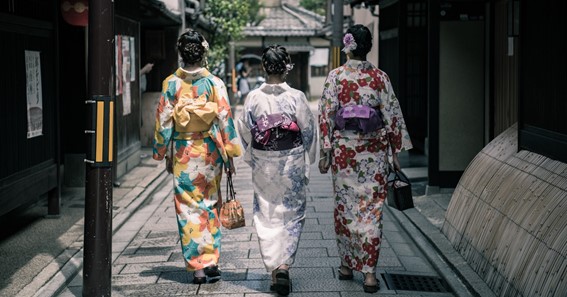Starting to learn Japanese online language, we are faced with the need to study, you’ll encounter various challenges encompassing phonetics, vocabulary, grammar, syntax, and morphology. The intricate language culture of the Land of the Rising Sun highlights vocabulary, grammar, and writing as some of the most complex aspects. However, fear not! By enrolling to learn Japanese in Sydney, you can gain additional advantages for your future travels to Japan.
Sydney, a city of diverse cultural experiences, offers an ideal environment for language learners. Immerse yourself in language schools, connect with native speakers, and engage in cultural events to fine-tune your skills. Imagine the joy of confidently ordering your favorite dishes at an authentic izakaya, navigating bustling city streets with ease, and bonding with locals through meaningful conversations. Learning Japanese in Sydney will equip you with the linguistic tools needed to immerse yourself in Japan’s rich cultural heritage and navigate daily interactions with confidence.
Don’t let the complexities deter you. Embrace the challenges of learning Japanese, and you’ll open the door to a more enriching and fulfilling travel experience. From the bustling city lights of Tokyo to the serene beauty of Kyoto, your journey through Japan will be enriched by your newfound language skills. So, start your language adventure in Sydney today, and prepare for unforgettable experiences that will stay with you long after your travels. But let’s talk about this in more detail.
Phonetics
As for phonetics, you will have to pay maximum attention to the distinct pronunciation of vowels, the placement of stresses, and the nuances of pronunciation. In general, because the alphabet is phonetic, what is heard, as a rule, is written.
Vocabulary
But the Vocabulary of this Asian language is quite rich. Numerous synonyms and homonyms cause the main difficulties. But their number and peculiarities of pronunciation make the learning process very interesting.
Morphology
Separately, it is worth saying a few morphological words. Unlike Britain, in Japan, adjectives and nouns do not change in the usual sense of the term for us: to change a comment, you need to add either a function word or a suffix to it, which, as it were, is glued to the word. This simple morphology is a consequence of the fact that Japanese belongs to the group of agglutinating languages.
click here – Things to Consider When Starting a Photography Business
Grammar
Students often find it challenging to place words in sentences correctly. So, if in English speech a simple sentence has the order: subject-predicate (verb) – object, then in Japanese: subject-object – predicate (verb). At first, this arrangement of words is confusing, but you need to get used to it. Actually, sometimes a change in word order is allowed, provided that the verb remains last.
Writing
Hieroglyphs are pretty tricky to learn. Katakana is used to write borrowed words, and hiragana is used to write inflected endings. Some are frightened that the roots of words are written in characters, the joyo kanji (generally accepted list) of which includes approximately 2000 of the most commonly used characters. But do not think it is unrealistic to learn them: it is easy to do in a little over a year, studying four or five characters a day.
Common Mistakes
The process of studying nihongo cannot be approached with European standards. Otherwise, mistakes are possible that can nullify all efforts or significantly complicate learning. Here are some of the most common mistakes in learning Japanese and how to solve them.
The Importance of Hieroglyphs
Today, Oriental and Asian languages are pretty popular, and many people want to learn them. The answer to this demand is the numerous courses and textbooks that offer to teach conversational speech without affecting writing. And, of course, some want to take the path of least resistance. But it would help if you did not do this because in Japanese Writing and spoken language are very closely related. In addition, reading provides the necessary immersion in the language culture and speeds up the learning process. And if the letter and grammar are ignored and subsequently needed, you will have to start learning again.
“On a note.” Sometimes some students sign the sound of foreign words above these words in the textbook. This bad habit has appeared since school days and significantly interferes with learning since the prompt insight interferes with the correct perception and understanding of words.
click here – A Guide on Creating Stunning Cinematic Videos
Hiragana and Katakana
You will often have to memorize by heart when learning Japanese, but many forget about katakana. It is much more common when trying to memorize hiragana. So, for example, by reading the hieroglyphs – kanu, you can provide yourself with excellent practice.
The strokes matter. Many believe that exactly how the hieroglyph was written does not matter. This is not the case since the order of the strokes in the image is very important. It is necessary to pay close attention to it from the moment of studying kana. The use of copybooks can significantly help in learning.
Words and Signs
Hieroglyphs cannot be memorized in isolation from the words where they are used. Of course, you need to know the meaning and read the hieroglyphs, but this must be done in parallel with the words being studied.
In the Land of the Rising Sun, the type of speech is of great importance (addressing women, men, older, younger, etc. has its characteristics), which must be formed from the very beginning of training. Of course, learning a foreign language is always tricky, but Japanese is so multifaceted that learning turns into an exciting and exciting process.

